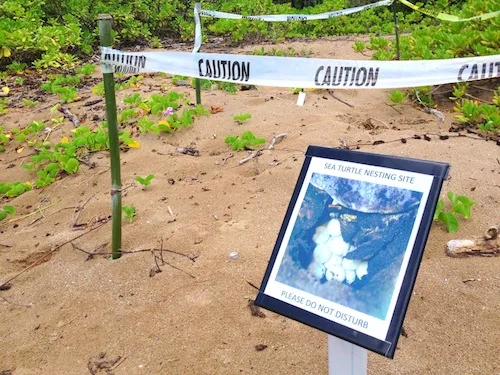Turtle Nesting in Hawaii

While summertime in Hawaii means longer days and beautiful weather, it also marks nesting season for green sea turtles. The honu, as they’re called in Hawaiian, choose specific beaches throughout the islands to lay their eggs. And because most of these beaches are frequented by humans, it is especially important that we show some respect when having fun in the sun.
You will likely see a nesting site roped off with caution tape and a sign posted to educate beach-goers on how to protect the area. Each clutch (nest of eggs) contains an average of 100 eggs buried beneath the surface of the sand. It is important that the eggs remain undisturbed for the full 60-day incubation period; although, sadly, it is not uncommon for stray animals to dig up and destroy these eggs.
Once the two months are up and around the time of a full moon, hatchlings emerge from their nest at night. Experts say that they are attracted to the moonlight reflecting off of the ocean and immediately start pecking their way out of the shell. Soon enough, hundreds of baby turtles dig their way up and through the layer of sand before crawling into the ocean.
The big question remains: Why don’t we see baby turtles when swimming in the ocean? According to NOAA, once hatchlings enter the ocean, they embark upon an oceanic offshore journey called the “Lost Years.” This can last up to a decade before they return to Hawaii’s nearshore reef habitats as small juveniles. Little is known about where the baby turtles go or how they survive. Isn’t that just amazing!?
Another rather amazing fact: Sea turtles will return to the nesting area where they hatched to reproduce. In Hawaii, according to NOAA, more than 90-percent of green turtle nesting takes place at French Frigate Shoals in the Northwestern Hawaiian Islands. I recently came across a nesting site on a south Kauai beach, where there were about 10 different nests marked off.
It is especially interesting to note that decades ago, the sight of honu in nearshore Hawaiian waters would have been rare. Today, we see them feeding, swimming and basking at almost every beach in Hawaii. That’s because, since the 1970s, they have become protected by the government, so consider yourself lucky every time you see a turtle in the islands.
Photo Courtesy (second): Hawaii Volcanoes National Park